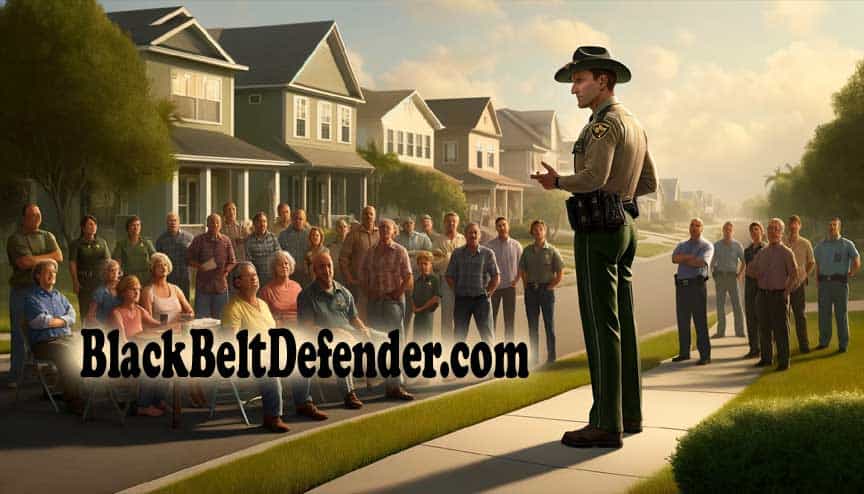
free shipping on orders over $49
We're having a 15% off sale on all our products. Enter your email below to be notified about future sales.




In an era where the dialogue around public safety and individual rights often finds itself at the heart of heated debates, a statement from the Santa Rosa County Sheriff in Florida has ignited discussions far beyond its local implications. Approximately a year ago, the sheriff publicly advocated for homeowners to use lethal force against home invaders, positing that doing so could not only save taxpayers’ money but also drastically reduce the likelihood of repeat offenses. This declaration, praised by some for its frankness and criticized by others for its perceived audacity, has since been linked to a significant downturn in home invasion incidents within the county to zero.
Reflecting on his controversial stance, Sheriff Zak Moyer highlighted a practical perspective on crime and self-defense. He pointed out the undeniable finality of the consequences for those who choose to violate the sanctity of someone’s home and meet a fatal end. His straightforward logic: an assailant who is neutralized can no longer pose a threat to the community. According to Moyer, this approach is not just about immediate deterrence but fostering a long-term understanding that criminal actions have dire repercussions.
The community’s response to Moyer’s remarks varied. Some residents expressed shock and concern over the implications of such a policy, while others saw it as a necessary stance in a society grappling with increasing instances of home invasions. This divide underscores the complex landscape of American attitudes toward self-defense and the role of firearms in civilian life.
Moreover, the sheriff’s call to action raises profound questions about the relationship between law enforcement, community safety, and the responsibilities of citizens within their own homes. By offering gun safety courses, Moyer emphasized not just the right to defend oneself but the importance of doing so responsibly and effectively. This proactive approach to community safety—equipping citizens with the knowledge and skills to protect themselves—challenges traditional notions of policing and public safety, advocating for a symbiotic relationship between law enforcement and the community.
Yet, this incident and the sheriff’s outspoken stance also reflect broader national conversations about crime, punishment, and the right to self-defense. In states like Florida, where laws robustly support the right to defend one’s home, such declarations from law enforcement officials resonate with a populace that values its Second Amendment rights. Conversely, in jurisdictions with more restrictive gun laws, the idea of civilians using lethal force in self-defense, especially as endorsed by a law enforcement officer, can be contentious.
This discourse extends beyond the specifics of gun rights or self-defense laws, touching on deeper societal issues such as the roots of criminal behavior, the efficacy of the criminal justice system, and the community’s role in ensuring its safety. It also highlights the varied landscape of American legal and cultural norms regarding self-defense, where the balance between ensuring public safety and upholding individual rights remains a topic of ongoing debate.
As the dust settles on Sheriff Moyer’s remarks and their aftermath, what remains clear is the necessity of a nuanced conversation about how communities can best protect themselves while fostering a culture that prioritizes prevention, education, and rehabilitation. The case of Santa Rosa County serves as a poignant reminder of the complexities surrounding crime prevention and the moral and ethical considerations of self-defense, urging a reevaluation of how society, law enforcement, and individuals can collaboratively work towards a safer, more just community.
The rising tide of criminal activity, bolstered by gun restrictions that are easily sidestepped by those with ill intentions, has underscored a critical flaw in our approach to public safety. Coupled with policies that err on the side of leniency and the establishment of gun-free zones that inadvertently serve as beacons for unchecked criminality, there’s a growing sentiment that our current strategies may inadvertently embolden those looking to do harm.
It’s become increasingly apparent that instilling a sense of hesitation in potential offenders—making them think twice before engaging in violent crimes, home invasions, and other illicit acts—is imperative. The prospect of encountering armed citizens, knowledgeable and equipped with self-defense weapons, could be a decisive factor in tipping the scales. This isn’t about fostering a society bristling with weapons but rather about recalibrating the balance of power, ensuring that law-abiding individuals aren’t left defenseless in the face of danger.
While well-intentioned, gun-free zones often fail to deter those who ignore the law, creating vulnerable spaces ripe for exploitation. A re-evaluation of such policies, focusing on empowering citizens to legitimately protect themselves and their communities, might just be the paradigm shift needed to deter criminal activity and restore a sense of security to our neighborhoods.
As always, be safe and be prepared.
See Also:
Black Belt Defender
1867 Caravan Trail #105
Jacksonville, FL 32216-2006
Call us toll-free: (800) 859-5566
Mon-Fri: 9:00 am – 5:00 pm EST
NH based, FL Warehouse
Online Orders: 24/7/365

